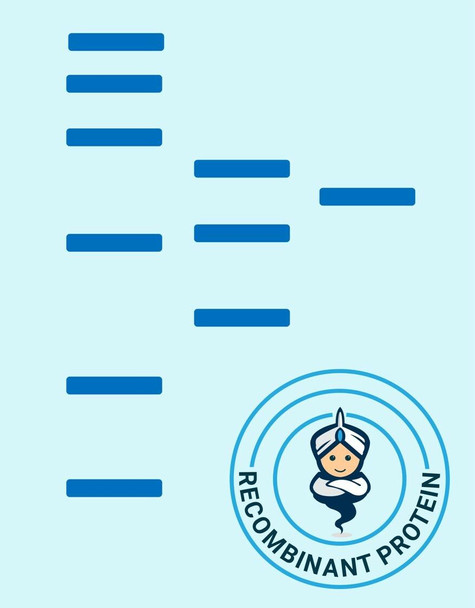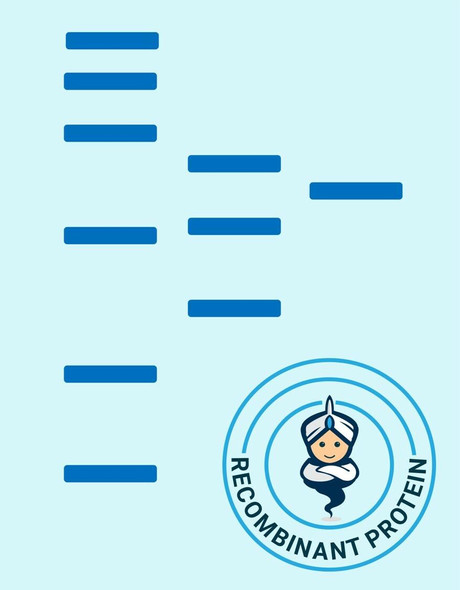Enzymes Recombinant Proteins
Human CASP2 Recombinant Protein (RPPB1470)
- SKU:
- RPPB1470
- Product Type:
- Recombinant Protein
- Species:
- Human
- Uniprot:
- P42575
- Research Area:
- Enzymes
Description
| Product Name: | Human CASP2 Recombinant Protein |
| Product Code: | RPPB1470 |
| Size: | 20µg |
| Species: | Human |
| Target: | CASP2 |
| Synonyms: | Caspase-2, CASP-2, CASP2, Caspase 2 Apoptosis-Related Cysteine Peptidase, Neural precursor cell expressed developmentally down-regulated protein 2, NEDD-2, Protease ICH-1, ICH1, NEDD2, Caspase-2 subunit p18, Caspase-2 subunit p13, Caspase-2 subunit p12, Caspase 2 isoform 1, PPP1R57. |
| Source: | Escherichia Coli |
| Physical Appearance: | Sterile Filtered colorless solution. |
| Formulation: | The CASP2 solution (1mg/ml) contains 20mM Tris-HCl buffer (pH 8.0), 0.4M Urea and 10% glycerol. |
| Stability: | Store at 4°C if entire vial will be used within 2-4 weeks. Store, frozen at -20°C for longer periods of time. For long term storage it is recommended to add a carrier protein (0.1% HSA or BSA).Avoid multiple freeze-thaw cycles. |
| Purity: | Greater than 80.0% as determined by SDS-PAGE. |
| Amino Acid Sequence: | MGSSHHHHHH SSGLVPRGSH MAGKEKLPKM RLPTRSDMIC GYACLKGTAA MRNTKRGSWY IEALAQVFSE RACDMHVADM LVKVNALIKD REGYAPGTEF HRCKEMSEYC STLCRHLYLF PGHPPT |
Caspase 2 Apoptosis-Related Cysteine Peptidase (CASP2) is a part of the cysteine-aspartic acid protease (caspase) family. CASP2 takes part in the activation cascade of caspases responsible for apoptosis execution. CASP2 is also responsible for inactivating proteins essential for cell survival. The proteolytic cleavage of CASP2 is induced by a variety of apoptotic stimuli.
CASP2 Human Recombinant produced in E.coli is a single, non-glycosylated polypeptide chain containing 126 amino acids (348-452) and having a molecular mass of 14.1kDa.CASP2 is fused to a 21 amino acid His-tag at N-terminus & purified by proprietary chromatographic techniques.
| UniProt Protein Function: | CASP2: Involved in the activation cascade of caspases responsible for apoptosis execution. Might function by either activating some proteins required for cell death or inactivating proteins necessary for cell survival. Heterotetramer that consists of two anti-parallel arranged heterodimers, each one formed by a p18 subunit and a p12 subunit. Interacts with LRDD. Expressed at higher levels in the embryonic lung, liver and kidney than in the heart and brain. In adults, higher level expression is seen in the placenta, lung, kidney, and pancreas than in the heart, brain, liver and skeletal muscle. Belongs to the peptidase C14A family. 2 isoforms of the human protein are produced by alternative splicing. |
| UniProt Protein Details: | Protein type:EC 3.4.22.55; Apoptosis; Protease Chromosomal Location of Human Ortholog: 7q34-q35 Cellular Component: membrane; mitochondrion; cytoplasm; nucleus; cytosol Molecular Function:protein domain specific binding; protein binding; enzyme binding; cysteine-type endopeptidase activity Biological Process: luteolysis; nerve growth factor receptor signaling pathway; DNA damage response, signal transduction resulting in induction of apoptosis; positive regulation of apoptosis; apoptosis; positive regulation of neuron apoptosis; germ cell programmed cell death; protein processing; brain development; proteolysis; regulation of caspase activity; DNA damage response, signal transduction by p53 class mediator resulting in cell cycle arrest; aging |
| NCBI Summary: | This gene encodes a member of the cysteine-aspartic acid protease (caspase) family. Caspases mediate cellular apoptosis through the proteolytic cleavage of specific protein substrates. The encoded protein may function in stress-induced cell death pathways, cell cycle maintenance, and the suppression of tumorigenesis. Increased expression of this gene may play a role in neurodegenerative disorders including Alzheimer's disease, Huntington's disease and temporal lobe epilepsy. Alternatively spliced transcript variants encoding multiple isoforms have been observed for this gene. [provided by RefSeq, Jan 2011] |
| UniProt Code: | P42575 |
| NCBI GenInfo Identifier: | 83300977 |
| NCBI Gene ID: | 835 |
| NCBI Accession: | P42575.2 |
| UniProt Secondary Accession: | P42575,P42576, Q59F21, Q7KZL6, Q86UJ3, Q9BUP7, Q9BZK9 Q9BZL0, A8K5F9, D3DXD6, E9PDN0, |
| UniProt Related Accession: | P42575 |
| Molecular Weight: | 10,309 Da |
| NCBI Full Name: | Caspase-2 |
| NCBI Synonym Full Names: | caspase 2, apoptosis-related cysteine peptidase |
| NCBI Official Symbol: | CASP2�� |
| NCBI Official Synonym Symbols: | ICH1; NEDD2; CASP-2; NEDD-2; PPP1R57�� |
| NCBI Protein Information: | caspase-2; protease ICH-1; protein phosphatase 1, regulatory subunit 57; neural precursor cell expressed developmentally down-regulated protein 2 |
| UniProt Protein Name: | Caspase-2 |
| UniProt Synonym Protein Names: | Neural precursor cell expressed developmentally down-regulated protein 2; NEDD-2; Protease ICH-1Cleaved into the following 3 chains:Caspase-2 subunit p18; Caspase-2 subunit p13; Caspase-2 subunit p12 |
| Protein Family: | Caspase |
| UniProt Gene Name: | CASP2�� |
| UniProt Entry Name: | CASP2_HUMAN |






